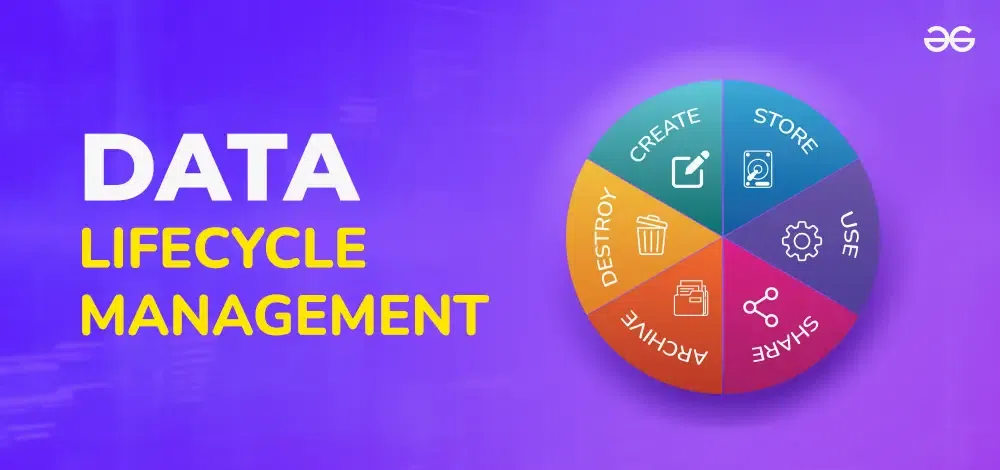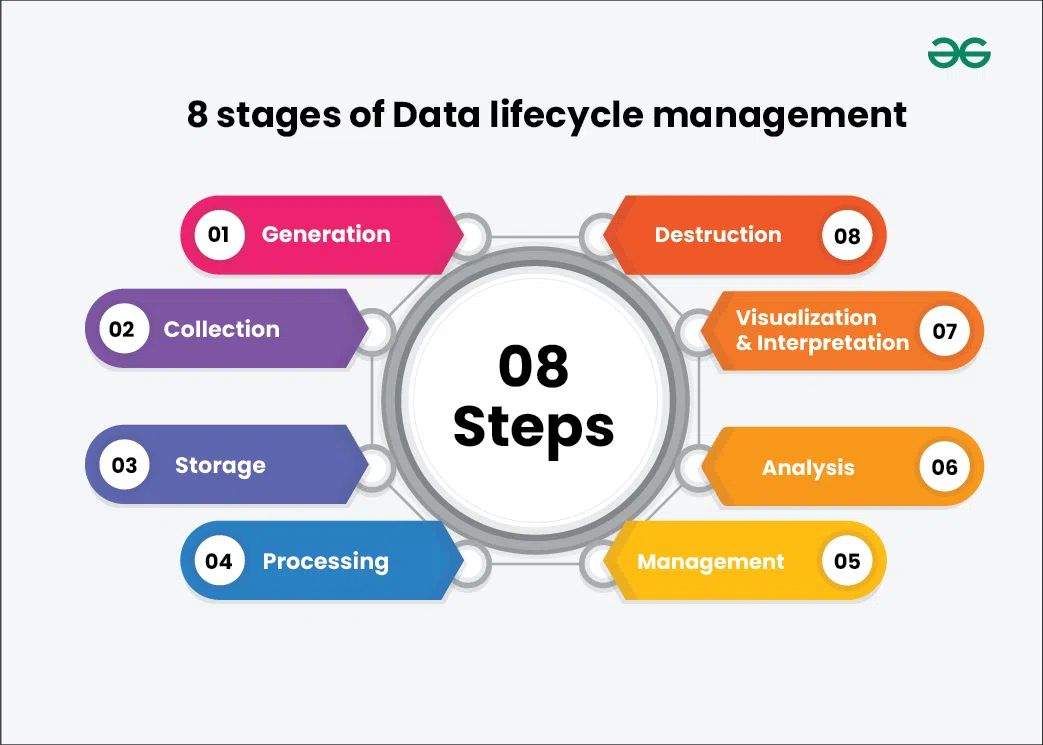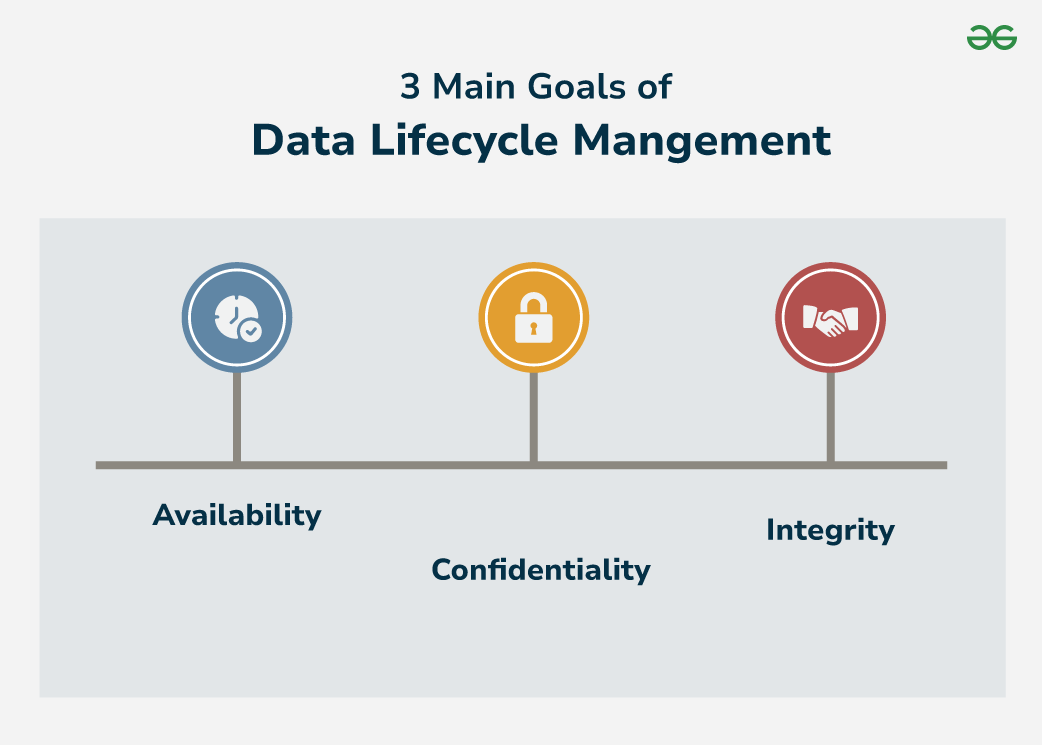What is Data Lifecycle Management?
Last Updated :
10 May, 2024
Data lifecycle management provides end-to-end visibility and control over the data flowing through systems and processes. It enables harnessing data as an asset at every stage – from planning through active use and eventual retirement. With strong data lifecycle management, organizations can channel data into a strategic advantage rather than suffer from overwhelming disarray.
This article will explore the key stages, practices, benefits, and implementation steps for robust data lifecycle management programs. With these foundations, organizations can transform even exponentially growing data from an unruly liability into a trustworthy and adaptable asset powering competitive advantage. Taming the data deluge through lifecycle management unlocks lasting business value.

Data LIfecycle Management System
The Critical Role of Data Lifecycle Management in the Era of Big Data
With data volume, variety, and velocity all exploding exponentially, effectively managing data has become a top priority. However static, siloed data lakes provide little strategic value. This is where implementing comprehensive data lifecycle management becomes critical – to keep pace with relentless data growth and complexity. When executed well, data lifecycle management delivers continuous visibility and control over the data deluge. It enables harnessing data as an asset for competitive advantage.
What is Data Lifecycle Management (DLM) ?
Data lifecycle management refers to the holistic set of practices for governing data from inception through retirement across the entire organization. It focuses on managing data seamlessly through all phases of its useful life – from planning and creation to processing, storage, utilization, archival, and deletion. Robust policies and procedures systematically cover data security, integrity, usability, costs, and regulatory compliance at each stage.
8 Stages of Data Lifecycle Management (DLM)
Here are the 8 main phases of the Data Lifecycle Management Process:

8 Stages of Data Lifecycle Management (DLM)
The 8 stages of the data lifecycle represent the journey data takes from its creation to its eventual deletion. It’s a crucial concept for organizations to understand in order to effectively manage, analyze, and leverage their data for maximum benefit. Here’s a breakdown of each stage:
- Generation: This is the starting point where data is created. In various industries, data generation can come from sources like customer transactions, sensor readings, social media interactions, or scientific experiments.
- Collection: Not all generated data is captured or useful. This stage involves identifying and gathering specific data points through methods like forms, APIs, or sensors.
- Storage: Safeguarding the collected data is essential. Here, data is placed in appropriate storage solutions like databases, data warehouses, or cloud storage.
- Processing: Raw data is rarely usable in its original form. Processing involves cleaning, organizing, and transforming the data into a usable format. This can include:
- Data wrangling: Correcting inconsistencies, missing values, or formatting errors in the data.
- Data compression: Reducing storage requirements by shrinking the data size without losing valuable information.
- Data encryption: Adding a security layer to protect sensitive data.
- Data transformation: Shaping the data for analysis, such as converting formats, combining datasets, or creating new calculated fields.
- Management: Data doesn’t manage itself! This stage involves maintaining the accuracy, security, and accessibility of data throughout its lifecycle. Think of it as keeping your data organized and protected.
- Analysis: This is where the magic happens! Processed data is analyzed to uncover patterns, trends, and valuable insights. Techniques like statistical methods, machine learning, and data mining are used here.
- Visualization & Interpretation: Data insights are presented in a visually compelling way using charts, graphs, or dashboards. This helps users easily understand the story the data tells.
- Destruction: Data doesn’t last forever. Some data may have legal or regulatory requirements for retention, while others may simply no longer be relevant. In this stage, data that has reached its end-of-life is securely deleted or anonymized to comply with regulations and ensure privacy.
What are the 3 Main Goals of Data Lifecycle Mangement ?

What are the 3 Main Goals of Data Lifecycle Mangement ?
Data Lifecycle Management (DLM) aims to achieve several key goals:
- Confidentiality: Data Lifecycle Management (DLM) ensures that only authorized users can access and use sensitive data. This is achieved through access controls, encryption, and other security measures.
- Integrity: Data Lifecycle Management (DLM) practices ensure that data remains accurate, complete, and consistent throughout its lifecycle. This involves data cleansing, validation, and version control techniques.
- Availability: Data Lifecycle Management (DLM) helps guarantee that the right data is readily available for authorized users whenever needed. This includes measures for data backup, disaster recovery, and performance optimization.
Data Lifecycle Management (DLM) Capabilities
Some of the major capabilites of Data Lifecycle Management (DLM) are as follows:
- Data Governance
- Centralized policies and standards: Establishes consistent rules for data creation, storage, access, and use across the organization.
- Metadata tracking: Provides a comprehensive view of data origin, transformations, and usage patterns.
- Data quality and validity monitoring: Ensures data accuracy and consistency through automated checks and alerts.
- Roles and responsibilities for distributed data stewardship: Defines ownership and accountability for data assets across different departments.
- Security controls aligned to classification levels, users, and environments: Implements appropriate security measures based on data sensitivity, user access levels, and where the data resides.
- Data Operations
- Automated data archiving, retention, and disposal tools: Streamlines data movement to different storage tiers based on age and legal requirements.
- Storage infrastructure optimization for cost and performance: Optimizes storage resources by allocating them efficiently based on data access patterns and performance needs.
- Backup and disaster recovery provisions for data availability: Ensures data accessibility in case of system outages or data loss.
- Data Analytics and Accessibility
- Data integration, preparation, and delivery pipelines: Enables seamless data integration and transformation for analysis.
- Cataloging of available data and lineage for discovery: Provides a searchable inventory of data assets and their origins for easy discovery and understanding.
These capabilities working together empower organizations to manage their data effectively throughout its lifecycle, from creation to disposal. This translates into improved data security, compliance, cost efficiency, and ultimately, better decision-making based on trustworthy and readily available data.
Benefits of Data Lifecycle Management (DLM)
Effective lifecycle data management confers multiple benefits:
- Greater Agility – Smooth data pipelines allow faster utilization of new data for enhanced decision making.
- Risk Reduction – Continuous controls improve data integrity, compliance, availability, and recovery.
- Storage Efficiency – Unneeded data can be automatically removed per retention policies to reduce costs.
- Productivity – Self-service access to high quality data accelerates analysis and insights.
- Innovation – Better enterprise data knowledge enables identifying new opportunities and applications.
- Trust – Documented data provenance provides confidence in analytical outcomes.
- Future-Proofing – Adaptable data architectures withstand evolving technologies and needs.
Implementing Data Lifecycle Management (DLM)
Key steps for implementing data lifecycle programs include:
- Defining data classes and assigning ownership – This enables policies tailored to data types.
- Creating data requirements for each lifecycle stage – This identifies necessary procedures and controls.
- Evaluating technologies and tools – Solutions should unify siloed data environments.
- Building metadata management capabilities – This is crucial for tracking data end-to-end.
- Establishing data quality standards – These quantify and monitor data health.
- Developing data retention schedules – These optimize storage costs and compliance.
- Piloting with high-value use cases – This demonstrates benefits and refines processes.
- Cultivating data steward roles – This distributed accountability model aids governance.
- Ongoing reviews and improvements – This continuous evolution keeps pace with data landscapes.
Expert Techniques for High-Impact Data Lifecycle Programs
Beyond the basics, mature programs leverage advanced techniques like:
- Using workflow automation across the lifecycle for efficiency.
- Building centralized data services and tools for reuse.
- Leveraging artificial intelligence for classification and quality monitoring.
- Developing multi-tiered storage strategies to balance cost and performance.
- Extensive use of master data management and data catalogs.
- Embedding data stewardship into cross-functional teams.
- Collaborative issue escalation and change control processes.
- Convergence of analytical sandbox environments for flexibility.
- Automating disposal of unused data replicas and versions.
- Monitoring adoption and success metrics to guide enhancements.
Tools and Technologies for Data Lifecycle Management
Data Lifecycle Management (DLM) is a critical process for organizations that collect, store, and use large amounts of data. DLM helps ensure that data is secure, compliant, and readily available for those who need it.
There are a number of tools and technologies that can be used to support DLM, including:
- Data Catalogs: A data catalog is a centralized repository that stores information about an organization’s data assets. This information can include the type of data, where it is stored, who owns it, and how it is used. Data catalogs can help organizations track their data assets and ensure that they are being managed effectively. Some popular data catalog tools include: Alation, Collibra, Informatica Enterprise Data Catalog.
- Data Classification Tools: Data classification tools can be used to identify and classify data based on its sensitivity. This information can then be used to determine the appropriate level of security for the data. Some popular data classification tools include: Informatica Data Classification, Privacera, Titus Classification Engine.
- Data Masking Tools: Data masking tools can be used to obscure sensitive data, such as social security numbers or credit card numbers. This can help to protect the data from unauthorized access. Some popular data masking tools include: IBM InfoSphere Guardium, Socrata DataBlur, Collibra Data Privacy.
- Data Encryption Tools: Data encryption tools can be used to scramble data so that it can only be accessed by authorized users. This is a critical security measure for protecting sensitive data. Some popular data encryption tools include: Thales Cloud Shield, Microsoft Azure Encryption Services, Amazon KMS.
- Data Archiving Tools: Data archiving tools can be used to move data to a lower-cost storage tier, such as tape or cloud storage. This can help organizations free up storage space on their primary storage systems. Some popular data archiving tools include: Veritas Enterprise Vault, Commvault Metallic, IBM Spectrum Protect.
- Data Warehousing and Business Intelligence (BI) Tools: Data warehousing and BI tools can be used to analyze data and extract insights from it. This information can then be used to improve decision-making. Some popular data warehousing tools include: Snowflake, Amazon Redshift, Microsoft Azure Synapse Analytics. Some popular BI tools include: Tableau, Power BI, QlikView.
The specific tools and technologies that are used for DLM will vary depending on the organization’s needs. However, all DLM solutions should include some form of data classification, security, archiving, and analysis.
Conclusion
In today’s exponentially expanding data landscapes, organizations can no longer allow data to proliferate recklessly as an uncontrolled liability. Instead, data must be strategically governed as an asset through comprehensive lifecycle management. By implementing centralized policies, integrated technologies, and distributed data stewardship, companies can gain control over their data from inception through retirement.
FAQ’s on Data Lifecycle Management (DLM)
1. What are some leading data lifecycle management software solutions?
Top solutions include InformaticaAxon, Oracle DI suite, IBM InfoSphere Optim, ASG Technologies, and Innovative Routines International. Diverse products focus on different capabilities.
2. How is data lifecycle management different than data governance?
Data governance defines overall policy and strategy. Data lifecycle management executes tactical plans across the data pipelines to fulfill the governance directives. The two work hand-in-hand.
3. Can data lifecycle management help manage compliance with regulations?
Yes, data lifecycle retention rules, access controls, enhanced metadata, and better disposal align well with many compliance requirements. But additional controls may still be needed.
Share your thoughts in the comments
Please Login to comment...